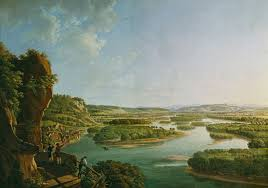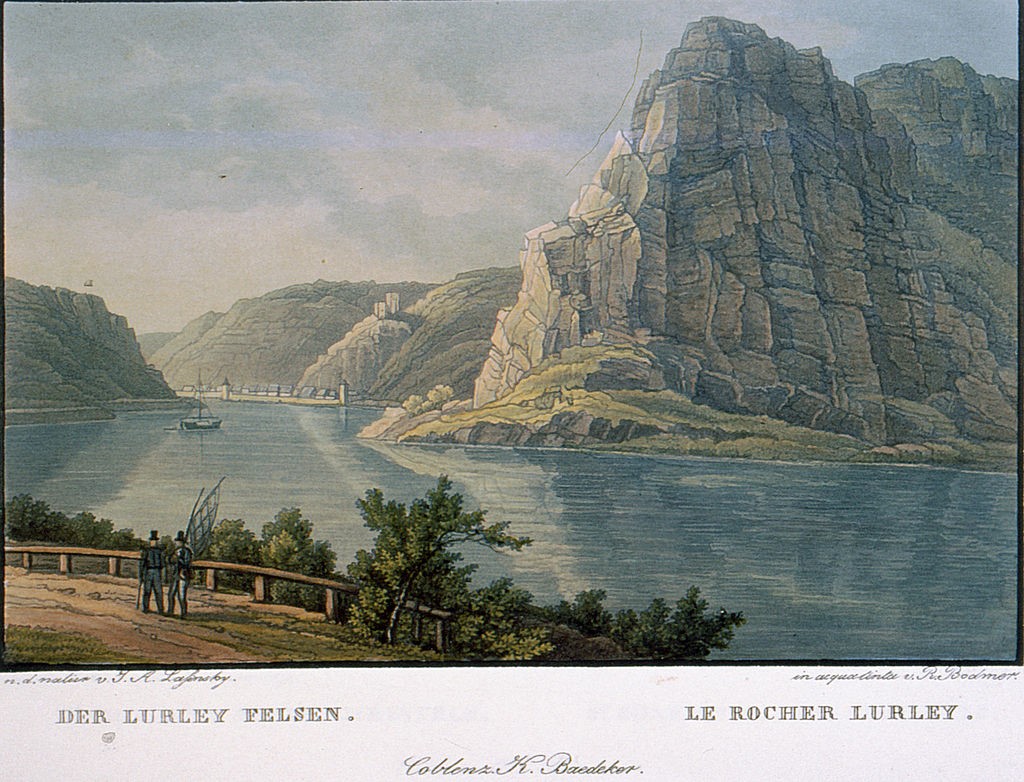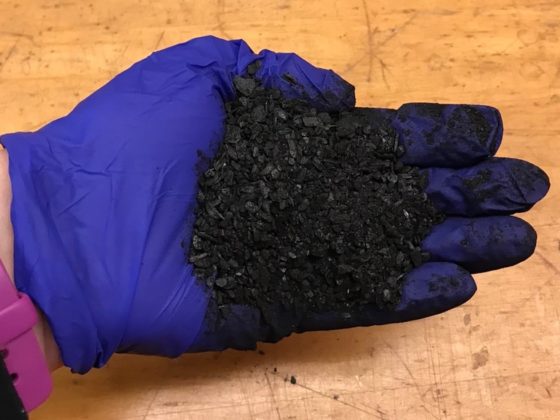As part of the eighth edition of the World Water Events, the Global Water Initiative in collaboration with the Center for German Studies invited David Blackbourn, the Cornelius Vanderbilt Distinguished Chair of History at Vanderbilt University. Blackbourn is the author of the award-winning book, The Conquest of Nature: Water, Landscape and the Making of Modern Germany. He is one of the first scholars to make the environment and how it has been shaped an integral element of his historical narrative. On April 12, he gave a zoom talk at the University of Virginia titled: “‘Time is a Violent Torrent’: Writing the River History of Modern Germany.” We talked to him afterward:
The river Rhine is very much associated with Germany. It played a key role in your talk and your book. At some point, you mentioned that especially the Middle Rhine, where the Lorelei (the rock on which, according to legend, a maiden lived who lured fishermen to their deaths, see picture above) is, was viewed as “the wild Rhine.” How much of this “wild Rhine” was man-made? What does this say about the concept of “nature” that we tend to espouse?
The Rhine does indeed have a very strong association with German national identity, going back to the era of the French Revolution and Napoleon. One of the fire-eating nationalists of that time, Ernst Moritz Arndt, famously described the Rhine as “Germany’s river but not Germany’s border.” A future German nation-state, in other words, would lay claim to the left bank as well. A political crisis over the Rhine in 1840 gave rise to a host of poems and songs that celebrated the river’s “German” character. One of them, “Die Wacht am Rhein” (The Watch on the Rhine), became one of the best-known patriotic songs of the nineteenth century and the first half of the twentieth century.
The rise of interest in the “Romantic Rhine,” the rocky gorge of the Middle Rhine between Mainz and Koblenz, with its dramatic basalt cliffs, vineyards, and castles, can be traced to the same decades. It was a product of the early nineteenth century. German writers celebrated its legends, like the Lorelei. But the politics of all this are complicated. The celebrated poem about the Lorelei that I, like thousands of others, learnt in school was written by Heinrich Heine, a German-Jewish democrat who lived in exile in Paris. Foreigners like the French writer Victor Hugo also did a great deal to create the popularity of the “Romantic Rhine.” So, above all, did the English, who had the money to travel and whose guidebooks told them that this was the “real” Rhine.
That brings me to your question. The “wild Rhine” was man-made to the extent that it came to be enjoyed by large numbers of tourists (still, for most of the nineteenth century, well-heeled tourists) who took their pleasure from the steamers that increasingly plied the river. It was from the steamer that the visitor could take in the “panorama”—that quintessentially nineteenth-century word. The passengers expected safe passage, though, as they traveled up or down the “wild” river, and the Romantic Rhine presented almost as many dangers to shipping as it did sights for tourists. A series of engineering measures therefore transformed the river to make the sightseeing safer. As I note in my book, engineers addressed the whirlpool at St Goarshausen, the “Wild Ride” at Bacharach, and the notorious Bingen Reef that threatened shipwreck at low water. Dynamite tripled the width of the Bingen Gap, the safe channel that ran between the rocks.
Even as it was celebrated for its Romantic qualities, therefore, the Middle Rhine gorge was as much a product of human intervention as the Upper Rhine to its south. That was the stretch of the river “rectified” between 1817 and the early 1870s under plans set out by the Badenese army officer and engineer, Johann Tulla, which forms the centerpiece of one chapter in my book.

You used the many (medium-sized) dams as examples of human interventions (the built environment). As you wrapped up your talk, you emphasized, I think, that one of the reasons why studying the history of rivers was important was that investigating “the human mastery of nature” also reveals something about the “nature of human mastery” of others. Can you give some examples of this in the German context, or in the context of other countries?
I see this as a central theme of my book as well as the talk. Dams are just one instance among many. As I don’t need to remind readers of this blog, water serves a very large number of human purposes. Rivers alone are a source of drinking water and of water for washing and bathing. They irrigate crops and provide calorific energy directly in the form of fish. They flush away waste and serve as a means of transportation (a river is a road that moves, said Blaise Pascal). They provide water for cooling and other industrial processes, and they drive both simple waterwheels and giant turbines. Some of these many ways of harnessing the river are mutually compatible, but not all. Every rearrangement of German hydrology I examine in the book—draining a marsh, redirecting and diking a river, digging a canal, building a dam—set rival users against each other.
These are what I called rupture points, when rivers or wetlands were remade to serve new interests. In the early years (and my book begins in the eighteenth century), the conflict was typically between fishing or hunting and agriculture; later it was between agriculture and industry; later still between one modern interest group (such as inland shipping) and another (such as hydroelectric power). There was almost always a clash of some kind between local or small-scale claims and larger interests. And almost always it was the big battalions who came out on top. That is why, in the book, the theme of human “mastery” over nature is thoroughly intertwined with the questions of who has power, whose interests prevail. In the words of one of Germany’s leading dam experts at the beginning of the twentieth century, “With mastery of the water comes the opportunity for conflict over it.”
Perhaps I could add one more point in answering your question. Powerful political and cultural attitudes were often revealed by great hydrological projects. That great drainer of wetlands, Frederick the Great, talked about making “conquests from barbarism.” The phrase applied to people as well as places. In the case of Prussian land that had previously been worked by Slav peoples, he spoke openly about the “slovenly Polish trash” and likened them to nomadic “Iroquois.” In this respect, the darkest episode of my history occurred during World War II in Nazi-occupied Europe. I deal with this in a chapter called “Race and Reclamation.”
In your book and in your talk you bring to the fore the hubris of hydrologists and engineers and their belief in their ability to control nature. You emphasize that, yes, maybe seasonal flooding can be prevented, but extreme weather events, after human interventions, may trigger catastrophic consequences. I am sure some of my colleagues in engineering who also emphasize sustainability these days may find that you don’t do justice to the engineering disciplines as they are now. Can you comment on this, and maybe give a sense of the extent to which, following the historical damming and canal-building phase, there has been an adjustment in Germany?
You’re right that my talk, with its three chosen episodes of engineering interventions between the 1740s and the 1920s, laid a heavy emphasis on hubris and the unintended (although not always unforeseen) outcomes of wetlands draining, river correction, and dam building respectively. That confident era lasted through the 1970s (a decade longer in East Germany), but at that point the engineers began to change their tune. Most new dam building ended by 1980 and few any longer wanted to defend the old gutter-and-downpipe approach to river engineering. The talk was now of “renaturing” and restoring wetlands, putting some meanders back into rivers. The question, in other words, was no longer whether to preserve, but how best to do it.
Trying to undo the effects of the most severe river canalization was harder than removing pollutants. To take up one of the points that came up in the questioning: it is possible on a river such as the Rhine to reintroduce something that resembles the original riparian wetlands in a few places (I walked in some of these areas twenty or so years ago, when I was preparing my book), and this also creates retention basins for floodwaters, easing the danger of downstream flooding that was one of the negative effects of the original “rectification.” But allowing the now much colder, faster-flowing river back into areas from which it was expelled as much as two hundred years ago presents a shock to the biotopes that have developed in the interim in the old side-arms of the river. And reintroducing salmon into this colder, faster-flowing river has proven even more of a challenge. The biggest problem is simply the limited room for maneuver, because on the Rhine and on other major river arteries, human settlement, agriculture, and industry have taken over so much of the floodplain beyond the straitjacketed river. Reversing that process is an altogether different task from removing concrete culverts from a rural stream as a form of “renaturing,” welcome though steps like that are.





